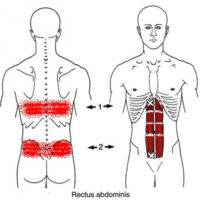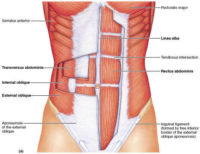
Rectus Abdominis – The Six Pack Muscle
Chronic Low Back Pain – Rectus Abdominis can develop trigger points that cause severe back pain. It may surprise you that the quest for a flat stomach does not strengthen your core. In addition, it often generates trigger points in this muscle. In the upper segment of the rectus abdominis, they refer pain in a horizontal band in the mid-back region. Taking a deep breath can aggravate these trigger points.
When these trigger points occur in the lowest section of the muscle they refer pain in a similar horizontal band low in the back. The pain can be mistaken for a variety of other types of back pain. It rarely feels as if there is anything going with the abdomen.
The first step in untangling any case of lower back pain is to confirm or eliminate more serious spinal injury or degeneration. Once these more serious factors have been examined we can focus on the soft tissue aspects of chronic lower back pain – rectus abdominis is just one them.
Rectus abdominis is one of the primary muscles of the abdomen. There are seven primary muscle groups that refer pain into the low back. This muscle on the front of the body is responsible for a significant amount of that of chronic low back pain.
Some of the leading causes of trigger point activations in the rectus abdominis include acute trauma and occupational strain. For instance, trigger points are likely to occur near an abdominal scar.
Paradoxical breathing often develops in response to the soreness of abdominal surgery. Then this breathing pattern perpetuates these trigger points.
What stresses rectus abdominis? Some factors are overall fatigue, emotional tension, viral infections, straining due to constipation and poor posture. Additional factors include cold exposure, carrying a backpack or walking uphill.
Sometimes, whether in spite of or because of regular abdominal workouts, active trigger points develop. The abdomen sags as the trigger points inhibit the muscle’s supportive function. Janda mentioned that the abdominals are generally prone to inhibition. They are a key muscle group in Janda’s Lower Cross Syndrome.
The overload caused by the repetitive vigorous contractions of sit-ups and can activate trigger points in the rectus abddominis.
Consider some of the many plank variations. We also like the eccentric contraction of Slow Sit-Backs instead when recovering from trigger points in the rectus abdominis.
Then, you can progress to abdominal curls. Finally, you can return to sit-ups, leg-lifts and other vigorous ab work if desired.
Whenever possible, try to use diaphragmatic breathing and abdominal bracing techniques during your work outs.
First, simply try to bring your breath into your belly. Next, attempt to brace your transversus abdominis (TA) against your breath. Finally, attempt to isolate the TA while keeping the rectus abdominis soft.
 The TA is the deepest of the core abs running across the upper abdomen and down the sides. It is the first muscle we gain conscious control of as infants. It assists our diaphragm in respiration and is used to bear down. Most importantly, the TA is the foundation for stability in virtual every other movement of the body. Abdominal bracing strengthens the TA and allows the other abs to remain more relaxed.
The TA is the deepest of the core abs running across the upper abdomen and down the sides. It is the first muscle we gain conscious control of as infants. It assists our diaphragm in respiration and is used to bear down. Most importantly, the TA is the foundation for stability in virtual every other movement of the body. Abdominal bracing strengthens the TA and allows the other abs to remain more relaxed.
 We often confuse the TA with rectus abdominis and work out the wrong ab muscle. To release the trigger points in the abs, we’ll apply some gentle self-compression and then work on stretching it.
We often confuse the TA with rectus abdominis and work out the wrong ab muscle. To release the trigger points in the abs, we’ll apply some gentle self-compression and then work on stretching it.
Self-release techniques for the abdominal muscles typically use fitness balls or softballs between your abs and the floor to target trigger points. You may find it difficult to support your body weight in one of this position. If so, try beginning with self-compression between the abdomen and wall instead.
Once trigger points in the rectus abdominis have been inactivated, the muscle can be stretched safely.  We’re considering exercises that extend the back and stretch the abdomen. This includes the lunges, warrior I pose and a gentle cobra pose (press-ups).
We’re considering exercises that extend the back and stretch the abdomen. This includes the lunges, warrior I pose and a gentle cobra pose (press-ups).
 You can also stretch the rectus passively, on your back, over a large fitness ball or bolster.
You can also stretch the rectus passively, on your back, over a large fitness ball or bolster.
Follow these stretches with child’s pose to gently stretch and relax the muscles of the low back and the glutes. Once you know you have cleared your abs of trigger points you can begin safely strengthening them again.
It’s actually divided into eight sections, but the divisions in this muscle are what give rise to the name. Rectus abdominis works with the other abdominal muscles, QL and diaphragm. Together, they increase intra-abdominal pressure for non-respiratory reasons.
When flexing the spine, rectus abdominis works together with the psoas and rectus femoris.
When walking or running, the rectus abdominis works to stabilize the trunk. It activates with the other abdominal and some spinal muscles in advance of the movement. It is inactive when standing or sitting.
How Can a Therapist Help You With Pain From Rectus Abdominis?
Most cases of chronic low back pain – rectus abdominus trigger point dysfunction rarely occurs in isolation. Most of us are busy, so designing a program that will provide the most benefit with the least time and effort expended is important.
You may find that gentle massage of specific abdominal areas is required. Many find that coaching for diaphragmatic breathing and abdominal bracing is helpful. We can explain the complex relationships of the abdominals to each other. We can also explain how this relates to other muscles that act on the hip and and low back.
In addition, skeletal variations can perpetuate dysfunction in the abdominals. These include leg length differences, asymmetry in the pelvis, short upper arms and pronated feet. A professional can help evaluate these factors and recommend simple corrective actions.


